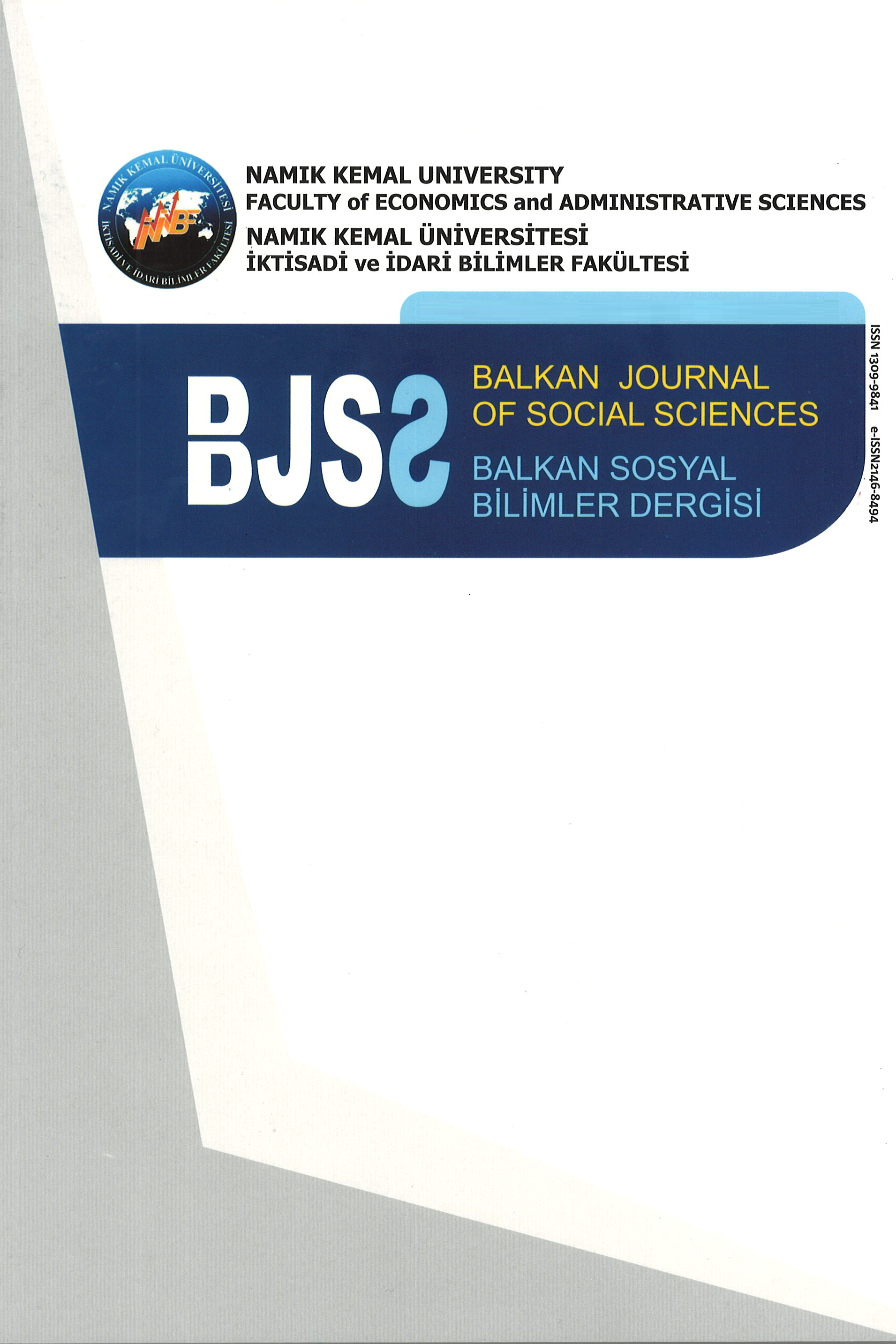VOLATİLİTEDE UZUN HAFIZA VE YAPISAL KIRILMA: BORSA İSTANBUL ÖRNEĞİ*
Bu çalışmanın amacı Borsa İstanbul’da etkin piyasalar hipotezinin geçerliliğini ampirik olarak araştırmaktır. Bu amaçla 1988 ile 2014 yılları arasında BİST100 ve BİST30 endeksleri için günlük kapanış verileri kullanılarak getiri serileri oluşturulmuş ve getiri serilerinin koşullu varyansında uzun hafızanın varlığı Baillie ve Morana (2009) tarafından geliştirilen Uyarlanabilir (Adaptive)-FIGARCH (A-FIGARCH) model ile araştırılmıştır. Analiz sonucunda, endeks getirilerinin varyansında çok sayıda yapısal kırılma noktası bulunmuş ve A-FIGARCH modelin getiri serilerini tahmin etmede daha üstün sonuçlar verdiği belirlenmiştir. Ayrıca, getiri serilerinin koşullu varyansının uzun hafıza özelliği gösterdiği ve buna bağlı olarak Borsa İstanbul’un zayıf formda etkin olmadığı sonucuna ulaşılmıştır.
Anahtar Kelimeler:
Etkin Piyasa Hipotezi, Uzun Hafıza, Rassal Yürüyüş, A-FIGARCH
LONG MEMORY AND STRUCTURAL BREAKS ON VOLATILITY: EVIDENCE FROM BORSA ISTANBUL
The aim of this paper is to examine validity of the efficient market hypothesis in Borsa İstanbul. Daily returns series are calculated by using daily closing price for BİST100 and BİST30 indices for periods of 1988-2014 and the presence of long memory on the volatility of the returns series is examined by means of Adaptive-FIGARCH (A-FIGARCH) model proposed by Baillie and Morana (2009). Empirical results suggest that there are multiple structural breaks on variance of returns series and A-FIGARCH model outperforms. In addition, it is found evidence in favor of long memory on the conditional variance of returns series and hence it can be said that Borsa İstanbul is not weak form efficient market.
Keywords:
Efficient Market Hypothesis, Long Memory, Random Walk, A-FIGARCH,
___
- Akkaya, G.C., Demirelli, E. & İbaş, E.. (2010). Finansal Piyasa Etkinliği: S&P500 Üzerine Bir Uygulama. Celal
- Bayar Üniversitesi İktisadi İdari Bilimler Dergisi, 11(2), 53.
- Andreou, E. & Eric, E.. (2002). Detecting Multiple Breaks in Financial Market Volatility Dynamics. Journal of Applied Econometrics, 17, 579- 600.
- Baillie, R. & Morana, C.. (2009). Modelling Long Memory and Structural Break in Conditional Variances: An Adaptive FIGARCH Approach. Journal of Economic Dynamics & Control, 33, 1577-1592.
- Belkhouja, M. & Boutahary, M.. (2010). Modeling Volatility with Time-Varying FIGARCH Models. Economic Modelling, France, 28, 1106-1116.
- Bollersley, T.. (1986). Generalized Autoregressive Conditional Heteroscedasticity. Journal of Econometrics, 31, 307-327.
- Christensen, B. J., Nielsen, M.O. & Zhu, j.. (2010). Long Memory in Stock Market Volatility and the Volatilityin-Mean Effect: The FIEGARCH-M Model. Journal of Emprical Finance, 17, 460-470.
- Disario, R., Saraoglu, H., McCarthy, J. & Li, H.. (2008). Long Memory in the Volatility of an Emerging Equity Market: The Case of Turkey. International Financial Markets and Money, 18, 305-312.
- El Hedi Arouri, M., Lahiani, A., Levy, A. & Nguyen, D.K.. (2012). Forecasting the Conditional Volatility of Oil
- Spot and Futures Prices with Structural Breaks and Long Memory Models. Energy Economics, 34, 283- 293.
- Engle, R. (1982). Autoregressive Conditional Heteroscedasticity with Estimates of the Variance of UK Inflation. Econometrica, 50, 987-1008.
- Floros, C., Jaffry, S. & Lima, G.V.. (2007). Long Memory in the Portuguese Stock Market. Studies Economics and Finance, 24, 220-232.
- Gil-Alana, L. A.. (2006). Fractional Integration in Daily Stock Market Indexes. Review of Financial Economics, 15, 28-48.
- Inclan, C. & Tiao, G.. (1994). Use of Cumulative Sums of Squares Retrospective Detection of Changes in Variance. Journal of the American Statistic Association, 89, 913-923.
- Karanasos, M. & Kartsaklas, A.. (2009). Dual Long-Memory, Structural Breaks and the Link between Turnover and the Range-Based Volatility. Journal of Empirical Finance, 16, 838-851.
- Korkmaz, T., Erdoğan, S. & Çevik, E.İ.. (2009a). VOB`da İşlem Gören Endeks ve Döviz Vadeli Sözleşmelerin Getirilerinde Uzun Hafıza Varlığının Test Edilmesi. İktisat İşletme ve Finans Dergisi, 24(274), 7-32.
- Korkmaz, T., Çevik, E.İ. & Özataç, N.. (2009b). Testing for Long Memory in ISE Using ARFIMA-FIGARCH Model and Structural Break Test. European Journals of Finance and Economics, 26, 186-192.
- Lamoureux, C. & Lastrapes, W.. (1990). Persistence in Variance, Structural Change and the GARCH Model. Journal of Business and Economic Statistics, 68, 225-234.
- Lobato, I. & Eugene, S.N.. (1998). Real and Spurious Long Memory Properties of Stock Market Data. Journal of Business and Economic Statistics, 16, 261-268.
- McMillian, D. G. & Ruiz, I.. (2009). Volatility Persistence, Long Memory and Time-Varying Unconditional Mean: Evidence From 10 Equity indices. The Quarterly Review of Economics and Finance, 49, 578- 595.
- McMillan, D. G. & Thupayagale, P.. (2008). Efficiency of the South African Equity Market. Applied Financal Economics Letters, 1-4.
- Newey, W. & West, K.. (1994). Automatic Lag Selection in Covariance Matrix Estimation. Review of Economic Studies, 61, 631-653
- Sanso, A., Arago, V. & Carrion, J. L.. (2004). Testing for Change in the Unconditional Variance of Financial Time Series. Revista de Economia Financiera, 4, 32-53.
- Tang, T. & Shieh, S.J.. (2004). Long Memory in Stock Index Futures Markets a Value-at-Risk Approach. Physica A, 366, 437-448.
- Yalama, A. & Çelik, S.. (2013). Real or Spurious Long Memory Characteristics of Volatility: Empirical Evidence from an Emerging Market. Economic Modelling, 30, 67-72.
- Yayın Aralığı: Yılda 2 Sayı
- Başlangıç: 2011
- Yayıncı: Tekirdağ Namık Kemal Üniversitesi
Sayıdaki Diğer Makaleler
11 YILLIK AKP YÖNETİMİ: GERÇEKLER VE BEKLENTİLER
TÜRKİYE’DE PARA POLİTİKASININ YAPISI VE PARA KURALI: 1990-2013 DÖNEMİ1
Nüket KIRCI ÇEVİK, Vedat PAZARLIOĞLU
Zlatka GRIGOROVA, Ekaterina ARABSKA
ÖRGÜTSEL STRES KAYNAKLARI VE BAŞ ETME YOLLARI: TEKİRDAĞ ADLİYESİ ÖRNEĞİ
Murat Selim SELVİ, Yaşar ERDEM, Yasemin KAYAR
VOLATİLİTEDE UZUN HAFIZA VE YAPISAL KIRILMA: BORSA İSTANBUL ÖRNEĞİ*
Emrah İsmail ÇEVİK, Gültekin TOPALOĞLU
YENİ TEKNOLOJİLERİN YÖNETİCİ ROLLERİ ÜZERİNDEKİ ETKİSİNİ SAPTAMA ÜZERİNE BİR ARAŞTIRMA
Korhan ARUN, Bahar TÜRKAY, Göksel FEN, Gülçe BABACAN, Nursel ATEŞ
